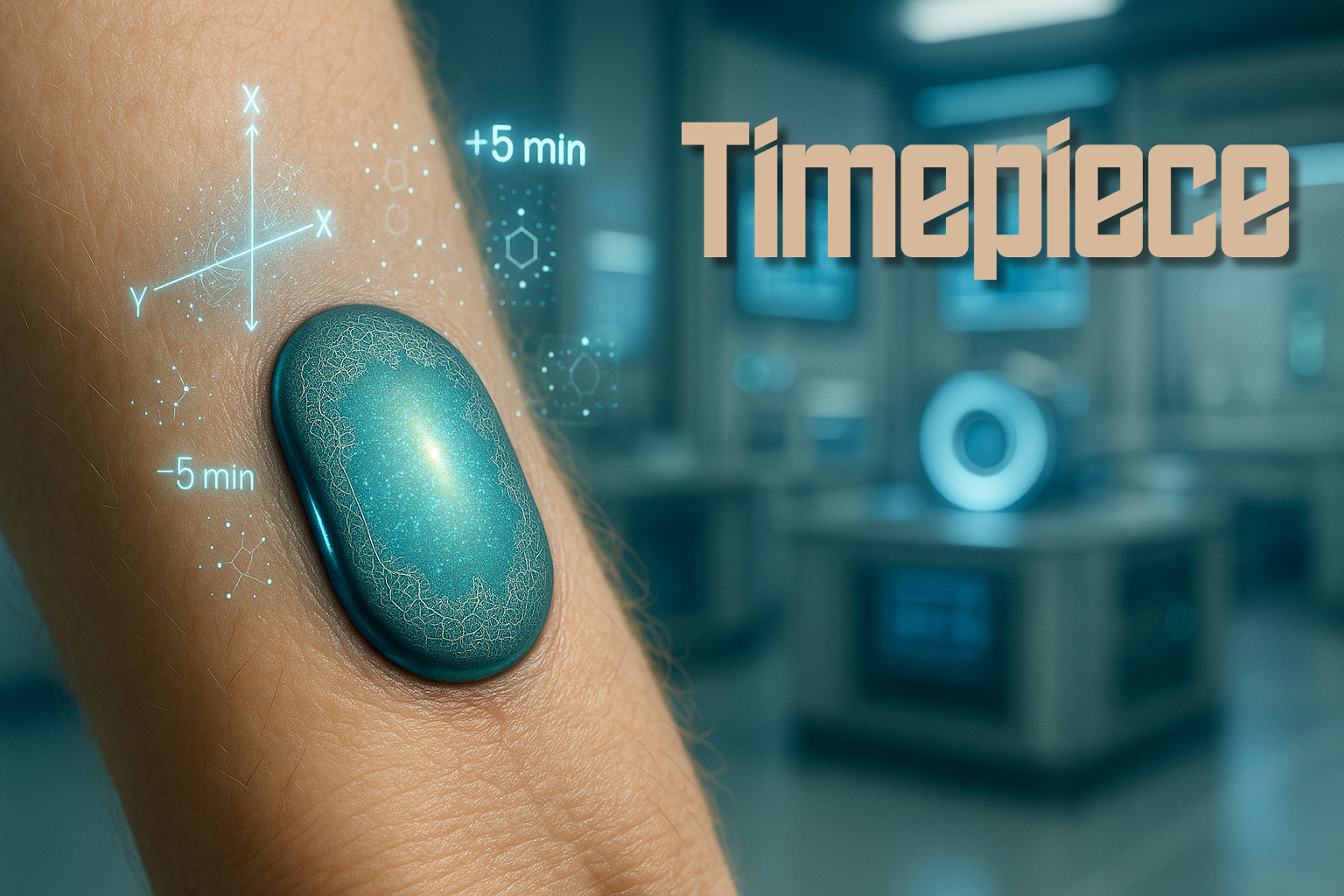Elena stood in the rain.
It wasn’t real rain, not exactly. The simulation field in the auxiliary chamber generated precipitation patterns based on archived weather data from the Oregon coast—mid-autumn, heavy overcast, intermittent mist. But the cold? That felt real.
She let it soak her, the chill seeping through her synthetic lab coat as if the water might wash away what she saw in the future. Her own body, broken. The unknown figure who watched her. A timeline unraveling at the edges.
Behind her, footsteps.
Raj.
“This isn’t helping your blood pressure,” he said softly.
“Neither is sitting still.”
He paused. “You still haven’t told me everything.”
Elena turned. Her face was hollowed out by exhaustion, eyes sunken but sharp.
“Because I don’t know how. The implant didn’t log his image properly. It says he had no definitive biological pattern. That shouldn’t be possible.”
Raj frowned. “Unless he wasn’t biological.”
She stared at him.
“You mean synthetic consciousness?”
“It’s a theory.” He glanced toward the inner chamber beyond the glass. “You said he looked right at you. That he smiled. That kind of recognition implies cognition. Awareness. Maybe intent.”
Elena folded her arms against the cold. “He didn’t feel like AI.”
Raj looked unconvinced. “Then what did he feel like?”
She hesitated.
“Old.”
———————
The next day, Elena sat with Lila in the deep archive lab, a rarely used sublevel that still smelled like vacuum-sealed plastic and ozone. The fluorescent lights above them buzzed at irregular intervals, like something alive was crawling behind the ceiling panels.
Lila adjusted her lenses. “I cross-referenced the visual distortion signature with all known implant projection failures. Nothing matched. Not even the early proto-designs from the Reiger Initiative.”
“So he’s not the result of a failed jump?” Elena asked.
“Not unless someone made a new kind of jump. Something that doesn’t follow the standard entropic decay curve.”
Elena stared at the flickering monitor.
“And you’re sure he wasn’t an echo?”
Lila shook her head. “Echoes can’t move independently. They’re tethered to memory, not volition.”
Elena leaned back, fingers curling into her palm.
“He looked at me like he knew I’d come. Not like he was surprised. Like he was waiting.”
Lila tilted her head. “Could be a breach. Could be something older than a breach.”
“You think he came from before our jump tech?”
“I think he came from before our understanding of causality.”
———————
Marcus called an emergency meeting that evening.
He didn’t ask. He commanded.
The conference chamber was narrow, with two wall-length screens and a central table lit from beneath by soft green. Elena, Raj, Lila, and Marcus sat equidistant, as if proximity might imply complicity.
He spoke without preamble.
“We’re halting all forward jumps.”
Lila blinked. “You don’t have the authority.”
“I do now. The oversight board was notified of the breach. The vote was unanimous.”
Elena sat upright. “You went above us?”
“No,” Marcus said, “the moment Elena reported the intruder, we all went above us. The board has issued a review.”
Raj exhaled sharply. “We need to study this figure, not bury it. If he can breach the future, he can breach us.“
Marcus stood. “We don’t know that. We don’t know what he is. And until we do, we don’t proceed. We run back-end diagnostics. System sweeps. That’s it.”
He turned to Elena.
“No jumps. You especially.”
———————
That night, Elena ignored the lockout codes.
Raj would’ve stopped her. Lila might’ve helped. Marcus? He’d fire her. Then rehire her under classified terms. Then fire her again. She didn’t care.
She needed answers.
So she broke into the fallback server room.
Here, in the quiet depths of the lab’s original network stack, she ran the only kind of simulation the board hadn’t locked down: deep pattern resonance. Not of the lab. Not of her vitals. Of the frequency that trailed the unknown figure—the decay signature.
And what she found made her blood freeze.
The decay signature was not a line. Not a pulse.
It was a code.
A repeating code, buried beneath the radiation patterns and time drift.
She translated it using old Soviet-era encryption software. Not because she thought it was Russian.
Because the pattern was based on Cold War-era quantum semaphore—a kind of time-stamped signal protocol theorized but never implemented. It only appeared in hypothetical data transfers involving closed-loop causal structures.
In short: Time loops.
———————
Elena stared at the decoded string.
TO THE ONE WHO SAW ME: YOU ARE LATE.
Below it, another.
FIND THE BLACK SINGULARITY.
And finally:
I AM WHAT COMES AFTER YOUR LAST QUESTION.
When she told Raj and Lila, the room went silent.
Raj was the first to speak. “This isn’t random. This isn’t an accident. He left the signal.”
Lila folded her arms, unsettled. “But how? The past is frozen. The future is chaos. Where do you leave a message that gets found in the now?”
Raj looked up slowly. “Unless he isn’t working inside the stream. Unless he’s writing outside of time.”
Elena paced.
“Black singularity. What does that mean?”
“Black holes?” Lila offered.
“No,” Raj said. “Black singularity isn’t a term we use for mass collapse. It’s theoretical. It refers to a data point in spacetime where causality erases itself. A rupture with no tether.”
Elena froze.
“A temporal zero.”
Lila nodded slowly. “The exact opposite of the frozen past.”
Raj stared at them both. “He’s trying to draw us there.”
Elena looked toward the inner corridor, where the time cradle waited in its glow.
“Then maybe that’s where we have to go.”
———————
Marcus wasn’t pleased.
Elena walked into his office uninvited.
He didn’t look up. “This better be a confession or a resignation.”
“Neither,” she said, dropping the printouts on his desk. “Read it.”
He skimmed. His jaw twitched. Then locked.
“You accessed unauthorized systems. Violated lockdown.”
“And found the only lead we have on the breach.”
He rose from his chair. “Do you understand what a black singularity is?”
“It’s a myth.”
“It was.” He tossed the printouts back at her. “Now it’s a threat. Or bait. And you want to walk into it?”
Elena leaned forward.
“I don’t want to. But we don’t have a choice. This… thing… it isn’t just in time. It’s writing time. Like a god who lost interest halfway through the first draft.”
Marcus sat slowly.
“And what if you walk into it and don’t come back?”
Elena smiled, bitter. “Then at least we’ll know why it’s rewriting us.”
———————
Preparations for the black singularity jump began in secret.
Only Raj, Lila, and Elena knew.
The cradle was retrofitted with new safeguards: dual-layer entropic shielding, enhanced causal anchoring, and a failback system that could reroute her consciousness into the lab’s synthetic memory cache if the implant failed.
It wouldn’t be safe.
But it might be necessary.
As the final checks were completed, Lila placed a hand on Elena’s shoulder.
“If you don’t make it back…”
Elena nodded. “I know.”
Lila held her gaze. “No, I mean really know. Not a hero’s nod. Not a martyr’s acceptance. This is a jump into a place that doesn’t exist. You may not either.”
Elena placed a small chip into her palm. “Upload this if I don’t come back. It contains the decay pattern. Someone else has to find him.”
Raj gave her a nod. “We’ll hold the anchor point as long as we can. But after three minutes, we pull the feed.”
Elena stepped into the cradle.
Lights dimmed.
The machine breathed.
Time collapsed.
And she jumped.



